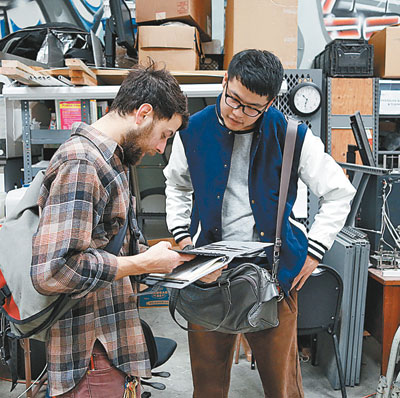
Anna Zhao anna.whizh@yahoo.com SHENZHEN makers who shared their experience of a visit to U.S. high-tech hub in Silicon Valley said they were most impressed by its “open and liberal” climate and the makers’ ability to quickly turn their ideas into reality. In an initiative to bolster Shenzhen’s innovation, 10 makers from the industries of hardware, Internet and industrial design paid a three-week visit in March to high-tech enterprises and maker spaces in Silicon Valley with the support of the Shenzhen Foundation for International Exchange and Cooperation. Aside from the must-visit spots of Google and Intel’s headquarters, they visited maker spaces such as Noisebridge and the Sudo Room, attended training at an incubator called Runaway, and visited the headquarters of crowdfunding website IndieGoGo. They also toured the accelerator GSVlabs, the biotech hackerspace Bio Curious, and the Institute for the Future. At Stanford University, they visited workshops that make 3-D printed products. Du Weiqiang, chief technology officer of Shenzhen Artop Innovation, said his understanding of U.S. maker spirit was “turning ideas into things as soon as possible and constantly improving what you’ve made.” Du was much impressed by the openness embraced by the maker school at Stanford University, which provides work environments and facilities for free to all students. He said U.S. makers consider the social needs for their products instead of the commercial value, opposite many Chinese makers. Jin Yan, the person in charge of the 2188 Maker Space of the Shenzhen Institute of Information Technology, said she has been trying to learn from the success of U.S. maker space TechShop while running her maker space for free. “It’s very encouraging to see people of the same interest form a maker club and do experiments together. Sometimes, people just drop their ideas when they lose interest. Still, the rate of turning out a successful product among U.S. makers is very high, given that they have vast resources, including a social network among club members. In comparison, it’s less likely for Chinese makers because they are more market-oriented,” she said. Yang Yang, founder of 3-D printing maker space UniMaker, said he is thinking about how to use what he learned in the United States in Shenzhen. “Many maker products in the U.S. are created primarily not for business purposes but to solve practical problems, for example, medical equipment to help disabled and children,” Yang said. He said his team plans to join hands with companies in Silicon Valley to develop a 3-D printing machine that can print textbooks for children with special needs. Huang Yurong, a professor from Shenzhen University who has been doing research on makers, said U.S. maker spaces were more diversified and professionally operated, and China has fewer nonprofit maker spaces with most of them in universities and schools, public libraries and charitable organizations. Liang Hong’en, general manager of ABI, said the journey changed his opinion about the level of innovation in Shenzhen. He said he noticed that the United States has a more favorable system for makers to grow than in China. He attributed the mature eco-system for makers to the emphasis on innovation throughout U.S. society, from education to workplaces. “While Chinese students are required to pass a unified examination, the U.S. students are encouraged to build things different from their peers. After graduation, they are required to create things unique at work, or, if not, they can still flex their creative muscles at maker spaces,” Liang said. He compared Shenzhen’s Huaqiangbei to a microcosm of an eco-system for makers but pointed out that new ideas were often short-lived there. He said new ideas die after three to six months if they don’t make a profit. David Li, founder of Shenzhen Open Innovation Lab, said that although Shenzhen’s native-grown maker culture is not as mature as in Europe and the United States, it still has its advantages as a global manufacturing hub for high-tech products with its complete industrial chain, manufacturing experience and market, which can be complementary to cities in Europe and the United States. Li said maker culture is revitalizing the manufacturing industry, presenting fresh opportunities for Shenzhen. “The world’s makers are eyeing opportunities with the Internet of Things. But the hardware necessary for turning their ideas into products is not made in Western countries where a large proportion of industry is service industry,” Li said. “In this circumstance, Shenzhen is attractive to global makers by providing hardware. It will give full play to innovation with its manufacturing capability. In this sense, Shenzhen will be a paradise for global makers.” Li said the trip to Silicon Valley also opened a window for the United States to understand the real Shenzhen because the 10 makers who are directly involved in product development in manufacturing and design enterprises represent the elite in these industries in Shenzhen. Feng Nan, executive secretary of the Shenzhen Foundation for International Exchange and Cooperation, said the visit is a good experiment at building a bridge between Shenzhen and the outside world. Feng said makers would visit Europe and the Middle East in the future to attract advanced technology and global talent to Shenzhen. “We hope the 10 makers will spread their experience to maker groups and push for progress in Shenzhen’s innovation industry just like sowing a seed,” Feng said. | 
